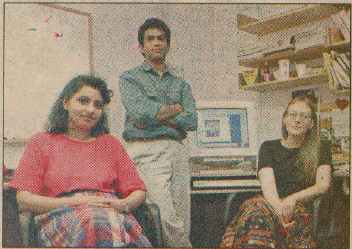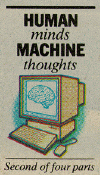
Buffalo, NY
Thursday, July 21, 1994
Page A1 and A11

Buffalo, NY
Thursday, July 21, 1994
Page A1 and A11

THIS IS A TEST: Dr. Rohini Srihari, research assistant professor in the UB computer science department, with her graduate students Rajiv Chopra, standing, and Debra Burhans, sitting next to computer in their office at the UB Commons. They are working on a computer system that automatically identifies people in News photographs based on accompanying captions.

By MIKE VOGEL
News Staff Reporter
The picture and caption with this story will be looked at and read by a few hundred thousand persons -- and one machine.
The people in the picture are trying to make it tough on the machine.
For you, the job is easy. There are three people in the picture, posed in a computer-equipped office.
If you want to know their names, you can read the caption. Sorting out the identities is easy enough for humans -- but it turns out to be pretty complex for even a powerful computer.
For Dr. Rohini K. Srihari, the deceptively simple task of scanning Buffalo News photographs and captions has turned into a major research project that could have far-reaching applications.
Her research team at the UB's Center of Excellence for Document Analysis and Recognition may be pioneering a path that will lead to intelligent robots exploring distant planets or smart medical probes deep within the human body.
"What we're trying to do is build a bridge between vision and language," she explained.
The system developed at CEDAR has been scanning News photos for years now, in an effort funded by the Defense Department's Advanced Research Projects Agency.
 The goal isn't just newspaper picture analysis, although that could have major
impacts on library and archive operations that now rely on manual cataloging
or "key word" computer searches.
The goal isn't just newspaper picture analysis, although that could have major
impacts on library and archive operations that now rely on manual cataloging
or "key word" computer searches.
The goal is a computer system that can understand plain English and tie spoken or written concepts to information that the computer "sees."
For a surgeon, that might be a probe that can respond to the comment "I'm looking for something small and red."
For a space scientist, it could be a robot that can "put the device between the rock and the ravine."
For a soldier, it could be an observer that can "find the enemy tank, somewhere beyond the airfield hangar."
Computers can't do that now.
Newspaper photos are a good place to start, Dr. Srihari thinks, because they combine both a picture and a caption.
"One is vision input, and the other is natural language input -- and these are probably the two biggest sub-disciplines in Artificial Intelligence," she said.
Consider the picture with this story. The caption -- developed by the UB team as a test -- provides some spatial and visual cues humans process automatically.
The computer, though, has to solve several puzzles and run through a series of combinations before finding a good fit between names and faces.
A program called PICTION will consider the caption -- what clues does it offer? Who is sitting, who is standing? Who is next to the computer? Who is male, who is female?
Then it will scan the image and identify several "candidates" as human faces. It will probably come up with more than three, thanks to some of the UB team's posing.
Then it will run through a series of constraints, such as spatial relationships and genders, to come up with a likely ID for each face.
PICTION, at its best, could retrieve, say, all pictures with images of Hillary Clinton -- whether she's identified in the picture by name, solely as "First Lady," or simply as "the president's wife."
The system also would be able to pull Mrs. Clinton's face out of the picture and offer it as a separate image, and store everything in a data base that would offer search possibilities beyond simple "key word" searches -- the researcher could communicate with the machine in plain English, to outline a request.
"We can figure out the 'mood' of a photograph, like whether it's a tragedy or celebration or a political situation, based on information in the caption," said Dr. Srihari, who has been working on the project since 1986.
A 1987 Buffalo News picture of the All-Western New York Boys' Volleyball Team, Dr. Srihari said, was "one of our real successes" because the caption identified the team as "surrounding" the coach, then named players from the left in both bottom and top rows.
PICTION scored, with the right IDs, even though its visual scan initially identified two extra "faces" -- a crossed pair of hands, and a knee brace on a bent knee.
"It makes mistakes also, simply because of accidental alignments of edges," Dr. Srihari explained.
The program works from words to images, because the grammar and other constraints in English have allowed better research advances in natural language processing than the relatively constraint-less world of visual discrimination.
"The whole point is to give enough information to the visual system to help it work," said Dr. Srihari.
Sometimes, there's an added twist in the information the computer must conquer.
"I've done a thesis on the kind of captions you write," she told a News reporter. "Just because somebody's mentioned in the caption doesn't necessarily mean he's in the picture."
So far, she added, "we have sort of specialized in face location and face identity." But the tam now is looking to expand the project into other types of images, as the next step on their journey into the future.